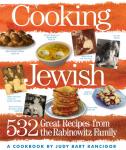
BUY COOKING JEWISH by clicking here now.
Merlot-Braised Short Ribs with Cipollini Onions
from “Food to Live By' by Myra Goodman with Linda Holland and Pamela McKinstry
seen in The Orange County Register
September 6, 2007
Yield: 8 to 10 servings
1 ounce dried porcini mushrooms
5 pounds boneless beef short ribs, or 7 pounds bone-in beef short ribs
Salt and freshly ground black pepper
4 tablespoons olive oil; divided use
2 carrots, coarsely chopped
2 ribs celery, coarsely chopped
2 small yellow onions, coarsely chopped
3 cloves garlic, peeled and thinly sliced
1 bay leaf
3 tablespoons fresh thyme leaves
1/4 cup tomato paste
1 bottle (750 milliliters) merlot
4 cups Slow Simmering Beef Stock (recipe follows) or store-bought low-sodium beef broth
12 ounces cipollini or pearl onions (12 to 16 onions)
1/4 cup good-quality balsamic vinegar
Procedure:
1. Soak dried mushrooms in 1 cup warm water until soft, at least 5 minutes. Drain mushrooms in a sieve set over a small bowl. Set mushrooms aside. Strain soaking liquid through a paper coffee filter, then set aside soaking liquid.
2. Position a rack in the lower third of the oven and preheat the oven to 350°F.
3. Dry ribs with paper towels, then liberally season them with salt and pepper.
4. Heat 2 tablespoons of the olive oil in a large, heavy ovenproof pot or roasting pan over medium-high heat. Working in batches if needed to avoid crowding the pot, add the ribs and brown well on all sides, 8 to 10 minutes per batch. Using tongs or
a slotted spoon, transfer ribs to a platter and set aside.
5. Reduce heat to medium and add remaining 2 tablespoons olive oil to the pot. Add carrots, celery, yellow onions, and garlic and cook, stirring occasionally, until vegetables begin to caramelize, 15 to 20 minutes.
6. Add bay leaf, thyme, and tomato paste to the pot and cook, stirring frequently, for 5 minutes.
7. Return ribs and any accumulated juice to the pot, stacking them to fit, if necessary. Add soaked mushrooms, mushroom soaking liquid, and merlot. Add 3 to 4 cups of the stock, enough that ribs are covered. Heat ribs over medium-high heat
until liquid begins to simmer.
8. Cover the pot tightly with a lid or aluminum foil. Bake ribs until tender when pierced with a fork, about 3 hours. Check the pot about every 30 minutes to make sure the sauce is gently simmering but not boiling. If needed, adjust the oven temperature to maintain a slow simmer.
9. Meanwhile, fill a large bowl of water with ice cubes and set aside.
10. Bring a medium-size saucepan of water to a boil over medium-high heat. Add the onions and cook until their skins loosen, about 2 minutes. Drain onions, then plunge them into the bowl of ice water. When cool enough to handle, peel onions, cutting a small sliver off the root end and pulling the skin off. Set onions aside.
11. Remove ribs from sauce, place them on a platter, and loosely cover them with aluminum foil to keep warm.
12. Let sauce rest for a few minutes until the fat rises to the surface. Degrease the sauce by skimming off the fat with a metal spoon or ladle.
13. Pour sauce through a strainer and discard the solids, including the bay leaf. Wash the pot and return the
sauce to it. Bring the sauce to a simmer over medium heat.
14. Add vinegar and onions to sauce,
then let it simmer gently until it is concentrated and the onions are
tender, 20 to 30 minutes. Add ribs and let simmer until they are warmed
through, then serve.
Nutritional information (per serving): calories
530 (68 percent from fat), protein 30.2 g, carbohydrates 8.6 g, fat
42.2 g (saturated 30.1 g), cholesterol 160 mg, sodium 212 mg, fiber 1.2
g
Source: “Food to Live By' by Myra Goodman with Linda Holland and Pamela McKinstry
Slow Simmering Beef Stock with Red Wine
Yield: 8 to 10 cups
10 pounds beef or veal bones, preferably with some meat attached
2 tablespoons olive oil
2 large yellow onions, unpeeled, cut into wedges
4 celery stalks with leaves, cut into 1-inch pieces
1 large carrot, unpeeled and cut into 1-inch pieces
8 cloves garlic, unpeeled
1 bottle (750 milliliters) dry red wine
1 can (28 ounces) diced tomatoes
1 teaspoon whole black peppercorns
Cook's note:To prevent
harmful bacteria from developing, cool stocks quickly after cooking
before refrigerating or freezing. Divide stock into small containers,
or use an ice bath: transfer stock to a clean pot and place in a pan
filled with ice water, stirring occasionally.
Procedure:
1. Position a rack in the lower third of the oven and preheat the oven to 450ºF.
2. Place meat bones in a large roasting pan in a single layer and
rub olive oil over them. (If necessary, arrange the bones in 2 pans to
avoid crowding, which could slow down the browning process.)
3. Roast the bones until they begin to brown, about 1 hour. Add onions,
celery, carrot, and garlic and continue baking, stirring occasionally,
until bones are deep brown, about 45 minutes.
4. Transfer bones and vegetables to a very large soup pot or divide
them between 2 pots, if needed. Add wine to the roasting pan and scrape
up any brown bits from the bottom of the pan. Pour this into the soup
pot and add just enough cool water to barely cover the bones, about 12
cups.
5. Bring liquid just to a boil over high heat, then reduce heat to low.
Using a large spoon, skim off any foam that accumulates on the surface.
6. Add tomatoes and peppercorns and let simmer gently, uncovered, at
least 6 hours or up to 12 hours, adding more water as needed to keep
the bones barely covered with liquid.
7. Remove and discard bones. Strain stock through a fine-meshed sieve
into a large, clean pot and discard the solids. If the stock tastes
weak, bring it to a simmer over medium heat and cook until reduced by a
third to intensify the flavor, 30 to 45 minutes.
8. If you are using the stock at this time, let it rest for a few
minutes so the fat rises to the surface, then skim it off with a metal
spoon or ladle. If not for immediate use, let the stock come to room
temperature using the quick cooling method (see Cook’s note).
Refrigerate stock, covered, until fat has solidified on the surface,
then discard fat. Stock can be refrigerated, covered, for up to 3 days
or frozen for up to 6 months.
Nutritional information (per cup): calories 150 (28 percent from fat), protein 21 g, carbohydrates 5.2 g, cholesterol 20 mg, sodium 144 mg, fiber 0.3 g

